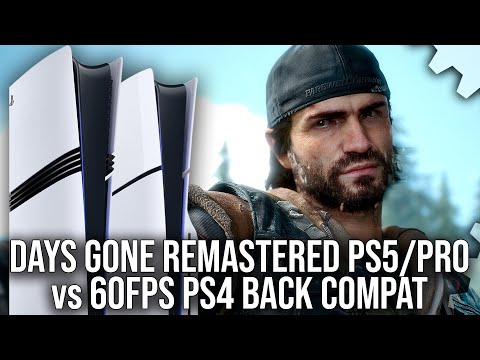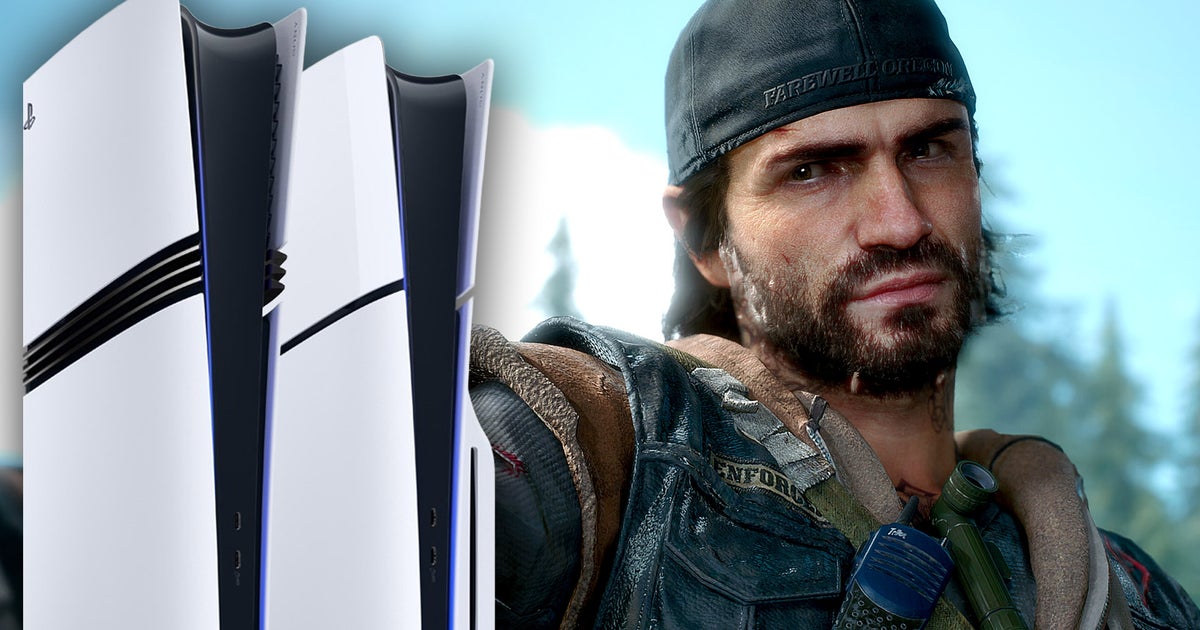Stop me if this headline sounds familiar: late period Sony PS4 title receives PS5 remaster. Yes, it’s yet another Sony refurbishing bonanza, this time focusing on Sony Bend’s underappreciated 2019 gem Days Gone. But unlike recent PS5 remastering efforts, this is much more than a simple resolution bump or frame-rate enhancement, packing new lighting effects that can transform the game’s appearance. Does Days Gone stick the landing on PS5 and PS5 Pro consoles? And can Sony Bend improve on the PS4 code without introducing visual compromises along the way?
Days Gone Remastered feels like a more substantial overhaul than we’ve seen from most Sony remasters, with the game’s lighting – especially at night – seeing dramatic changes. The original release had unusually bright night-time scenes, while the remaster opts for a more realistic presentation with darker shadows, less ambient light and more impactful lighting emitted from the player’s trademark motorcycle. Safe zones also appear darker despite the presence of artificial lights, while skies possess far more visible stars – as you’d expect in the post-apocalypse.
Depending on the conditions and surrounding lights though, sometimes the difference between the original and the remaster is less pronounced, and the game never reaches true darkness outdoors for obvious gameplay reasons. Freaker fights are balanced around being able to make out enemies at range, and that is only somewhat diminished in this new iteration. Visibility shouldn’t be much of an issue.
 Days Gone Remastered DF Review – PS5/PS5 Pro – An Improvement Over PS4 Back Compat? It’s Complicated
Days Gone Remastered DF Review – PS5/PS5 Pro – An Improvement Over PS4 Back Compat? It’s ComplicatedCutscenes are given a longer leash, and can often be extremely darker with reworked lighting that can cast more dramatic shadows on characters. Back lights and key lights have a real intensity now, and work with the subsurface scattering to produce a sense of translucency on skin. Even though the assets and animation can appear very similar between the two versions, the updated lighting can change the complexion of cutscenes to good effect.
That’s not the only tweak, because Sony Bend and co-developer Climax Studios have overhauled the game’s lighting simulation during other conditions as well. According to the developers, they’ve updated the game to use a 16-band spectral model instead of computing sky scattering calculations in RGB, and they’ve simulated more phenomena within that model, like ozone absorption. For example, sometimes the sky has a more vibrant shade of blue behind the cloud cover, and that’s reflected in a cooler world that takes that light blue contribution in mind when it calculates the indirect lighting for any given scene. Sometimes this difference is stark, but most of the time it’s only really obvious with a direct comparison. Overcast conditions are usually affected the most, as you might expect.
There are other lighting tweaks as well. Screen-space global illumination has been adapted here from the PC release, which has a subtle but impactful effect on the game. This is most noticeable in interior scenes, with more realistic lighting and shadowing that better grounds objects in their environment. It’s seen some evolution over the PC code, and I think it does improve the game’s appearance. It also has an impact outdoors, most noticeably in the grass, which has lighter occlusion at its base.
Shadow resolution has also been doubled according to the game’s development staff. Some shadows appear only marginally sharper, but most environmental shadows have much crisper and less aliased outlines. This can trade-off a bit with realism in some circumstances though, such as chain-link fences that leave a strong stencil of occluded light even many feet away.
There are other tweaks as well. Texture resolution gets a bump for instance, as the game’s texture streaming has been improved in accordance with the game’s doubled memory. Screen space reflections appear more accurate too, though some of the puddles appear to be bugged now. Deacon also now has a flashlight hanging from his chest, which has been added to explain his in-game flashlight ability. But in general, the vast majority of the visual differences come down to the game’s lighting overhaul.
There is one change that I don’t really understand. Days Gone now has a configurable FOV, which is a helpful addition to improve comfort. But the default value is 70 degrees, while the original game is closer to 76 in my testing, perhaps falling between 76 and 77. I don’t understand why this was changed. Even more befuddling, the FOV in cutscenes was also lowered – but the in-game FOV settings have zero impact on these scripted scenes. These always appear slightly zoomed relative to the original shots, no matter what you do.
I think Days Gone Remastered is a success on a visual level in a lot of ways, but it’s bound to be controversial when it comes to image quality. The PS4 code on PS5 ran at ~60fps at a checkerboarded 4K resolution. It wasn’t perfect, as foliage and hair could artefact and alias with the checkerboarding technique, but it was reasonably clean and quite sharp. In contrast, the base PS5 in performance mode here runs at 1440p with no temporal upsampling process like FSR 2 to improve clarity, leaving it somewhat soft and imprecise relative to the PS4 code. There is some DRS on the horizontal axis here – along with every other mode on PS5 and PS5 Pro – although I didn’t find evidence of it in typical play.
The extent to which you can perceive the clarity difference will depend on your display and how far you tend to sit from it, but in side-by-sides it’s clearly less detailed than the version we’ve had for the past four-and-a-half years on PS5 consoles. Image stability is typically comparable, but image sharpness takes a considerable backseat. There are some minor advantages – most obviously in eliminating checkerboarding artefacts in screen-space effects – but on the whole I think it is an inferior image.
Frame-rates do see a bump over that vintage code, thankfully. The PS4 version on PS5 wasn’t a perfectly locked 60fps, with frequent dropped frames during open world traversal and more significant performance drops in very large scale combat scenarios (most notably against especially massive Freaker hordes in challenge mode). VRR unfortunately couldn’t help out the PS4 code on PS5, as VRR is disabled for PS4 software.
In the native PS5 code, those little hitches are totally ironed out in my experience, producing a perfectly smooth ride through the game’s post-apocalyptic environments. This is the most significant frame-rate improvement in typical play. Combat with large masses of Freaker hordes still suffers from drops occasionally, though they are smaller than the older code. Smaller groupings of Freakers, like in the game’s new Horde Assault mode, run without issue. PS5 doesn’t have any bespoke VRR modes, but it can benefit from VRR display timings if you have it enabled in the settings menu to smooth out any drops.
Loading times have also been improved, albeit by more modest margins. In my testing across three loads, the game emerges into gameplay about 10-12 seconds faster than its PS4-derived counterpart. It’s not the lightning-quick storage-to-pixels response that we are used to seeing from current-gen titles like Forspoken, but I don’t think it’s egregious either. And once you are in-game, it’s a mostly loading-time-free experience, outside of fast travel and certain breaks between cutscenes.
Quality mode steps up image clarity dramatically, typically rendering at native 4K. It’s sharper than both the versions we’ve surveyed so far – the performance mode at 1440p and the PS4 code at a checkerboarded 4K. It’s also more stable than both of those iterations, and doesn’t suffer from any checkerboarding gremlins. It’s a very satisfying image in my experience, and in particular excels at depicting fine foliage detail relative to the two others. Other top-line tweakables appear unchanged, like foliage draw-in, though the increased resolution helps you to appreciate the detail that is present in the game. That improved image quality does force you to swallow a 30fps frame-rate target, but it’s at least a locked 30fps in my experience. That’s probably not a sacrifice worth making for most players, but it’s nice to have the option.
Moving on to Sony’s new PS5 Pro console, we get three new mode options: a performance mode, a quality mode, and a new enhanced mode that uses PSSR. The performance mode is essentially identical to the base PS5 performance mode, except that the resolution target is bumped from 1440p to 1800p – a slim improvement in terms of clarity and temporal stability. The old code running at 4K with CBR remains king in detail resolved, though checkerboarding artefacts obviously get the boot on Pro.
The enhanced mode also runs at 60fps, with a 1584p internal resolution upscaled to 4K with PSSR. This mode has a certain noisiness to it, with PSSR exposing low-resolution edges during movement and blurring moving foliage, but it also looks sharper and is worth experimenting with. Either way, you get a locked 60fps experience barring those extremely large challenge mode hordes.
PS5 Pro’s final mode is a quality mode that runs at a full 5K resolution – 2880p – that’s downscaled to 4K. It looks marginally cleaner than the PS5’s quality mode, but again the drop to 30fps is too large of a sacrifice for most to consider it.
| Load Times | PS4 code on PS5 | Native PS5 |
|---|---|---|
| Initial Load | 42.4s | 32.3s |
| Drowned Them Like Rats mission | 27.6s | 15.4s |
| Ascending from the Underworld mission | 42.6s | 32.2s |
Looking back on the original Days Gone, time has been good to the game. It’s still one of the better looking UE4 releases, with lush forests and crisp screen-space shadows, superb lighting in its open world and filmic, PBR-driven materials – which all ran well on the 2013-vintage PS4 hardware. The game did have its limitations, such as poorer lighting quality in interior spaces and occlusion issues from the use of screen-space shadows and AO, but it’s only with the recent use of RT for more complex lighting and shadows and continuous LOD systems that we’ve seen major advancements beyond what Days Gone presented.
As a story-driven single-player experience, with an open world and side content more as set dressing, I think Days Gone continues to more than hold its own. That holds especially true on PS5 and PS5 Pro systems, where a solid 60fps experience is easily achievable, greatly improving the game’s raw mechanical feel. Plus, driving around on the in-game bike is still delightful, especially once you pack on a few upgrades.
The remaster as a whole has produced good if not exceptional results, with the revising lighting and boosting settings improving the presentation while the faster hardware allows for better performance too. However, there is a substantial image quality trade-off here, at least on base PS5 consoles. The Pro fares better against the original code, but its performance modes still aren’t a clean upgrade over the original checkerboarding, flawed as it might be. The game is set to receive some additional options too, including a 40fps mode on both consoles and extra VRR-enabled unlocked modes, which should be arriving in an upcoming patch.
At a $10 asking price, I think Days Gone Remastered has done enough to warrant a try for fans of the original, and it offers a somewhat more compelling option for new players than the PS4 code. It’s not the most critical remastering effort around, but it’s a definite improvement in many respects over what we had before.
